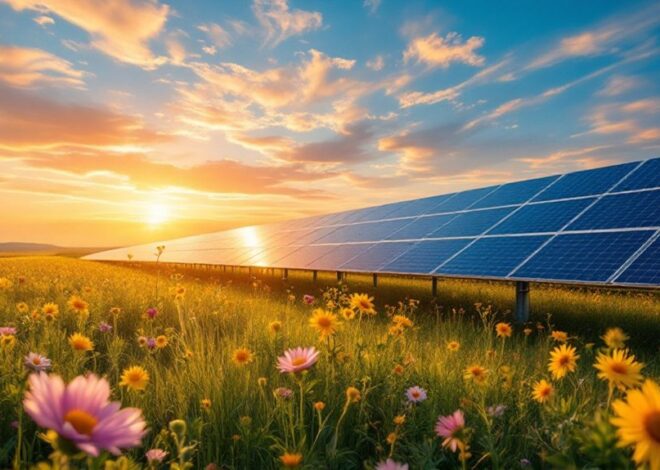
How Do Various Solar Panels Compare in Efficiency?
The efficiency of solar panels varies greatly among different types. Monocrystalline panels stand out with higher efficiency rates, while polycrystalline and thin-film options present distinct advantages and drawbacks. Understanding these differences is essential for making informed decisions. Factors such as space, cost, and environmental conditions play a role in choosing the right type. The implications of these choices can impact energy production and overall effectiveness. What might these factors mean for individual needs and installations?
Overview of Solar Panel Types
Solar panels come in various types, each designed to meet specific energy needs and efficiency standards. The three primary categories are monocrystalline, polycrystalline, and thin-film solar panels. Monocrystalline panels are known for their high efficiency and sleek design, utilizing single-crystal silicon for better performance in limited spaces. Polycrystalline panels, made from multiple silicon crystals, offer a balance of cost-effectiveness and efficiency, although they generally rank lower in performance compared to their monocrystalline counterparts. Thin-film solar panels, made from layers of photovoltaic material, are lightweight and flexible, making them suitable for a variety of applications, albeit with lower efficiency. Each type presents unique advantages and disadvantages, catering to different residential and commercial energy requirements. As the renewable energy sector continues to grow, advancements in solar technology are expected to improve efficiency and affordability.
Efficiency Ratings: What Do They Mean?
Understanding efficiency ratings is essential for consumers evaluating solar panels, as these ratings indicate the percentage of sunlight that can be converted into usable electricity. Typically expressed as a percentage, higher ratings denote greater efficiency in harnessing solar energy. For instance, a panel with a rating of 20% converts 20% of the sunlight it receives into electricity, while the remainder is lost as heat or reflected light. This metric is vital for determining the performance of various solar panel types, as it directly impacts energy output and system size requirements. Additionally, efficiency ratings can influence installation decisions, as higher efficiency panels may require less space and can be more cost-effective over time, making them a significant factor in solar energy investments. Moreover, selecting panels with higher efficiency can lead to reduced energy consumption, which is critical for a sustainable future.
Monocrystalline vs. Polycrystalline Panels
When evaluating solar panels, one of the key distinctions lies between monocrystalline and polycrystalline technologies. Monocrystalline panels are made from a single crystal structure, resulting in higher efficiency rates, typically ranging from 15% to 22%. Their uniform appearance and compact design allow for greater energy production in smaller spaces, making them ideal for residential installations. Conversely, polycrystalline panels are composed of multiple crystal structures, which yields a lower efficiency range of around 13% to 16%. While they are generally less expensive to produce, their larger size may require more roof space. Additionally, monocrystalline panels often have better performance in low-light conditions compared to their polycrystalline counterparts, influencing consumer choices based on specific energy needs and budgets. Practicing mindfulness can help individuals make more informed decisions about their solar panel investments.
Thin-Film Solar Panels: Pros and Cons
While monocrystalline and polycrystalline panels dominate the market, thin-film solar panels offer a unique alternative with distinct advantages and disadvantages. These panels are lightweight and flexible, making them easier to install on various surfaces, including curved structures. Additionally, they perform better in low-light conditions and high temperatures, which can be beneficial in certain climates. However, their efficiency tends to be lower than that of crystalline options, requiring more space to generate equivalent power. Thin-film panels also have shorter lifespans and may degrade faster over time. Despite these drawbacks, their lower production costs can make them an attractive choice for specific applications, particularly where weight and flexibility are prioritized over maximum efficiency. As with hybrid work models, organizations are adapting to find the best solutions for their needs.
Factors Affecting Solar Panel Efficiency
Several key factors influence the efficiency of solar panels, including temperature effects, light absorption capabilities, and the orientation and tilt of the panels. Higher temperatures can reduce electrical output, while ideal light absorption is essential for maximizing energy conversion. Additionally, the angle at which panels are installed greatly impacts their ability to capture sunlight throughout the day. Embracing minimalism in lifestyle can also lead to a more efficient use of energy, as it encourages focusing on quality and purpose in every aspect of life.
Temperature Effects on Efficiency
As solar panels convert sunlight into electricity, their efficiency is markedly influenced by temperature, with higher temperatures generally leading to decreased performance. This phenomenon occurs because elevated temperatures can reduce the voltage output from the solar cells, ultimately lowering the overall efficiency of energy conversion. Various types of solar panels exhibit differing sensitivities to temperature changes. For instance, monocrystalline panels tend to perform better in high-temperature conditions compared to polycrystalline panels. Additionally, the temperature coefficient of a solar panel indicates how much its efficiency decreases with each degree Celsius increase in temperature. Effective cooling methods and installation strategies can mitigate the negative impact of high temperatures, thereby enhancing the long-term performance of solar energy systems.
Light Absorption Capabilities
Light absorption capabilities play an essential role in determining the efficiency of solar panels. The ability of a panel to absorb sunlight is influenced by its material composition and design. Monocrystalline panels, known for their high purity silicon, generally exhibit superior light absorption compared to polycrystalline panels, which contain a mix of silicon crystals. Additionally, thin-film solar panels, while less efficient overall, can absorb light effectively due to their layered structure. Factors such as surface texture and anti-reflective coatings also enhance light absorption by minimizing reflection and maximizing light penetration. Ultimately, the efficiency of a solar panel is greatly affected by how well it can convert incoming sunlight into usable energy, making light absorption a critical consideration in solar technology.
Panel Orientation and Tilt
Proper panel orientation and tilt are essential factors that considerably influence the efficiency of solar panels. The angle at which solar panels are installed can considerably affect their ability to capture sunlight throughout the day. Ideally, panels should face true south in the Northern Hemisphere and true north in the Southern Hemisphere to maximize exposure to the sun. Additionally, the tilt angle should be adjusted according to geographic location and seasonal changes to optimize solar energy absorption. A flat installation may result in reduced output, particularly in winter months when the sun’s path is lower in the sky. By optimizing orientation and tilt, homeowners can enhance energy production, ultimately leading to greater savings and increased sustainability.
Real-World Performance: Case Studies
While many solar panels demonstrate high efficiency ratings in laboratory conditions, their real-world performance can vary considerably based on factors such as location, installation angle, and environmental conditions. Case studies reveal significant differences in energy output among various panels when deployed in diverse climates. For instance, monocrystalline panels often outperform their polycrystalline counterparts in sunny regions, while thin-film solar panels may excel in shaded or humid environments. One notable case in a coastal area showed that installations with ideal tilt angles harvested up to 20% more energy than those with suboptimal angles. Additionally, panels exposed to dust and pollution experienced reduced efficiency, highlighting the importance of maintenance. These findings underscore the complexity of solar panel performance outside controlled testing conditions.
Choosing the Right Solar Panel for Your Needs
When selecting a solar panel, it is essential to evaluate individual energy needs, budget constraints, and environmental conditions. Consumers should assess their energy consumption patterns and determine the required wattage to suit their lifestyle. Budget plays a significant role; different solar panel types, such as monocrystalline, polycrystalline, and thin-film, vary in price and efficiency. Environmental factors, such as local climate and roof orientation, can also impact panel performance. For instance, monocrystalline panels perform better in limited space and low-light conditions, while polycrystalline panels may be more cost-effective for larger installations. Ultimately, a thorough comparison of efficiency ratings, warranties, and installation costs will guide consumers toward making an informed decision that aligns with their specific circumstances and energy goals.
Frequently Asked Questions
How Long Do Solar Panels Typically Last?
Solar panels typically last between 25 to 30 years, with many manufacturers offering warranties for this duration. Over time, their efficiency may decline slightly, yet most remain functional well beyond the warranty period.
Can Solar Panels Work in Cloudy Weather?
Solar panels can indeed function in cloudy weather, though their efficiency decreases. Even with reduced sunlight, they convert available light into energy, allowing for continued power generation, albeit at lower levels compared to sunny conditions.
What Maintenance Do Solar Panels Require?
Solar panels require minimal maintenance, primarily involving regular cleaning to remove dust and debris, inspections for damage, and monitoring system performance. Ensuring clear pathways for sunlight optimizes efficiency and prolongs the lifespan of the solar installation.
Are There Tax Incentives for Solar Panel Installation?
Tax incentives for solar panel installation exist at federal, state, and local levels. These incentives can greatly reduce upfront costs, promoting renewable energy adoption and making solar power more accessible to homeowners and businesses alike.
How Do Solar Panels Impact Home Value?
Solar panels generally enhance home value by appealing to eco-conscious buyers, reducing energy costs, and potentially qualifying for tax incentives. Their installation often leads to increased property appreciation, making homes more attractive in competitive markets.
Conclusion
In summary, the efficiency of solar panels varies greatly among the different types, each catering to distinct needs and environments. Monocrystalline panels excel in performance and compactness, making them ideal for residential use, while polycrystalline options provide a more budget-friendly alternative at the cost of efficiency. Thin-film panels, though less efficient, offer flexibility for specialized applications. Ultimately, understanding these differences allows consumers to make informed decisions tailored to their specific energy needs and environmental conditions.



